TOYOTA AVALON HYBRID 2018 Owners Manual (in English)
Manufacturer: TOYOTA, Model Year: 2018, Model line: AVALON HYBRID, Model: TOYOTA AVALON HYBRID 2018Pages: 492, PDF Size: 7.3 MB
Page 421 of 492
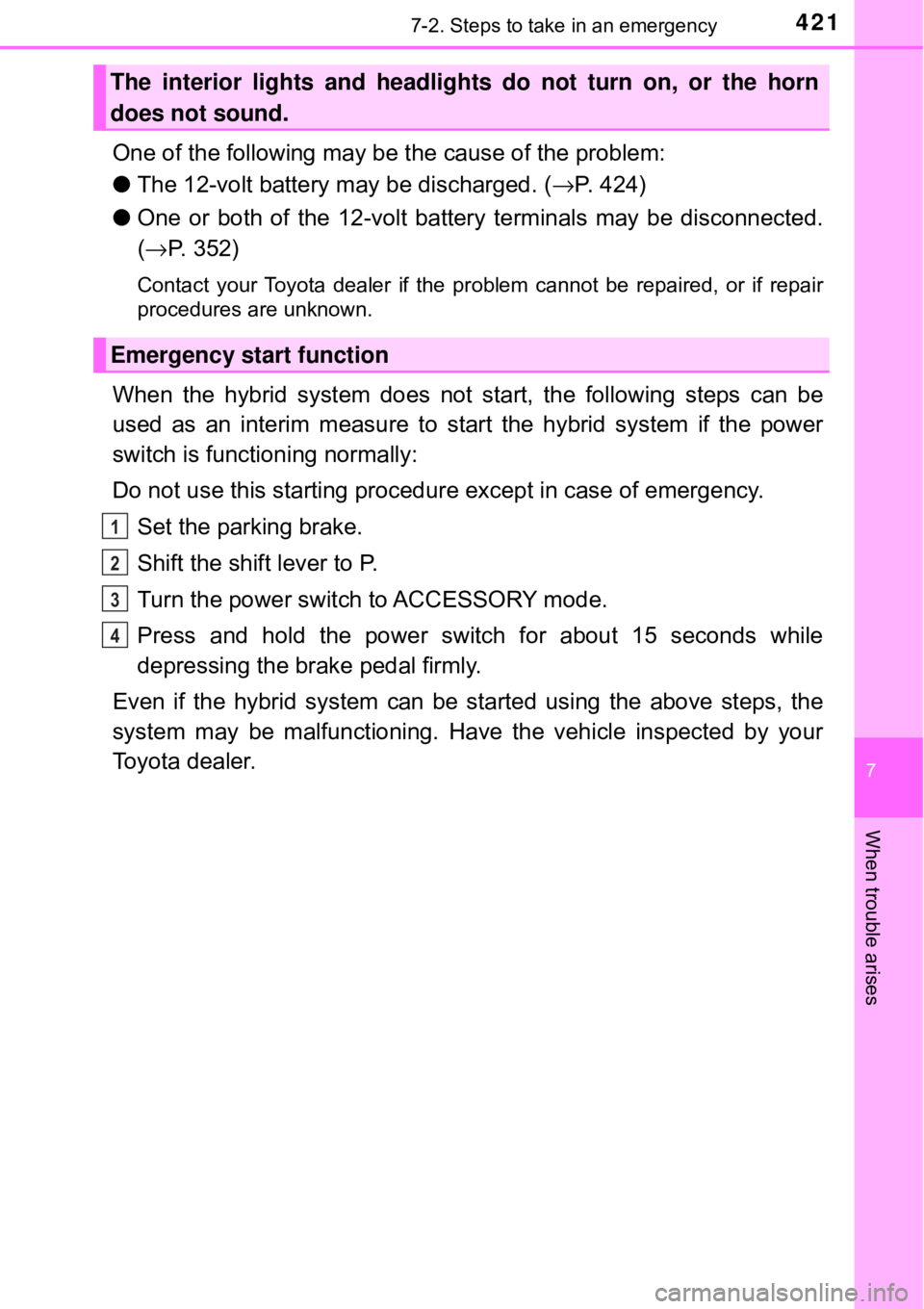
4217-2. Steps to take in an emergency
7
When trouble arises
One of the following may be the cause of the problem:
●The 12-volt battery may be discharged. ( →P. 424)
â—Ź One or both of the 12-volt batter y terminals may be disconnected.
( → P. 352)
Contact your Toyota dealer if the problem cannot be repaired, or if repair
procedures are unknown.
When the hybrid system does not start, the following steps can be
used as an interim measure to star t the hybrid system if the power
switch is functioning normally:
Do not use this starting procedure except in case of emergency.
Set the parking brake.
Shift the shift lever to P.
Turn the power switch to ACCESSORY mode.
Press and hold the power switch for about 15 seconds while
depressing the brake pedal firmly.
Even if the hybrid system can be started using the above steps, the
system may be malfunctioning. Have the vehicle inspected by your
Toyota dealer.
The interior lights and headlight s do not turn on, or the horn
does not sound.
Emergency start function
1
2
3
4
Page 422 of 492
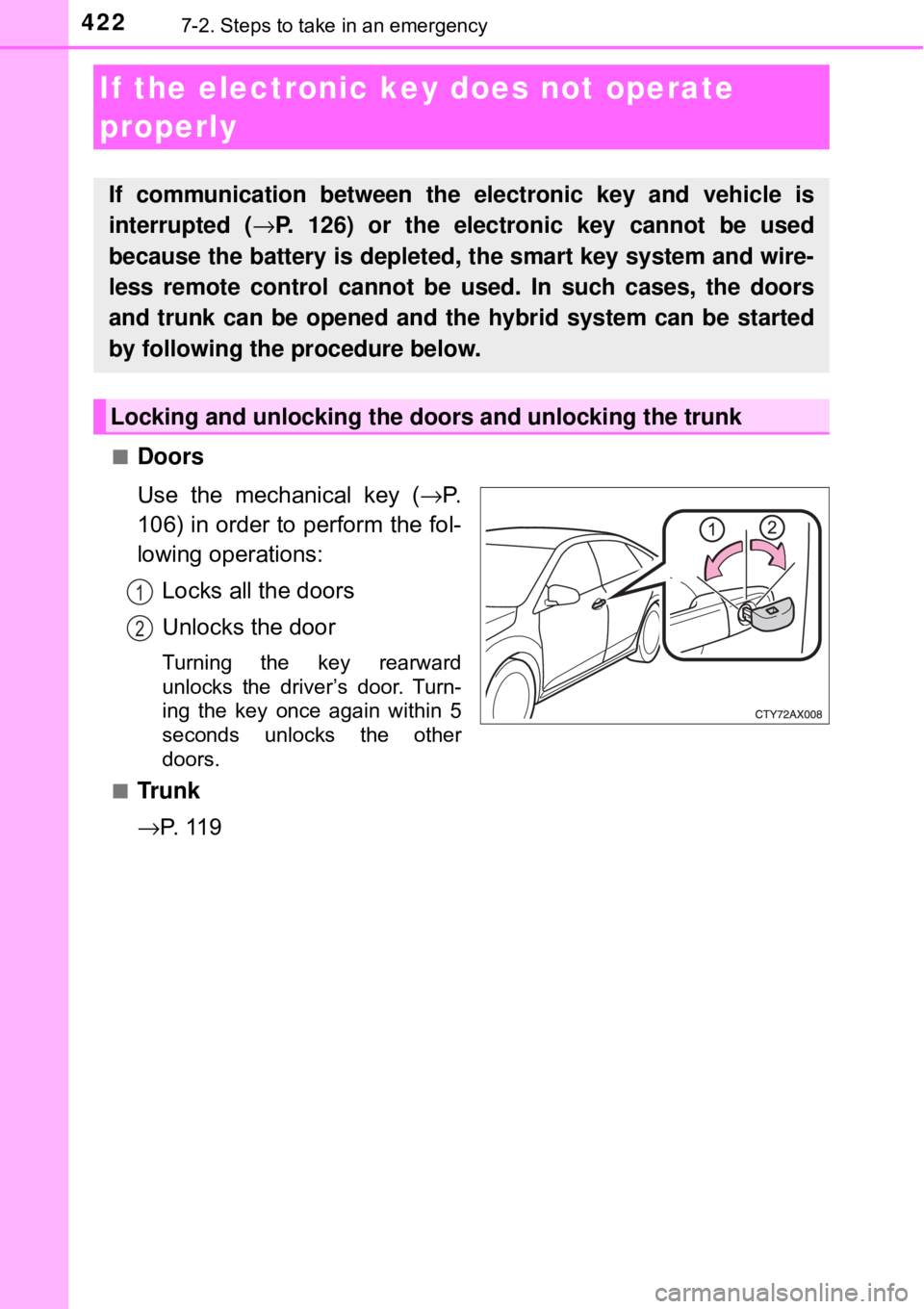
4227-2. Steps to take in an emergency
â– Doors
Use the mechanical key (→P.
106) in order to perform the fol-
lowing operations:
Locks all the doors
Unlocks the door
Turning the key rearward
unlocks the driver’s door. Turn-
ing the key once again within 5
seconds unlocks the other
doors.
â–
Tr u n k
→ P. 1 1 9
If the electronic key does not operate
properly
If communication between the electronic key and vehicle is
interrupted ( →P. 126) or the electronic key cannot be used
because the battery is depleted, the smart key system and wire-
less remote control cannot be used. In such cases, the doors
and trunk can be opened and the hybrid system can be started
by following the procedure below.
Locking and unlocking the doors and unlocking the trunk
1
2
Page 423 of 492
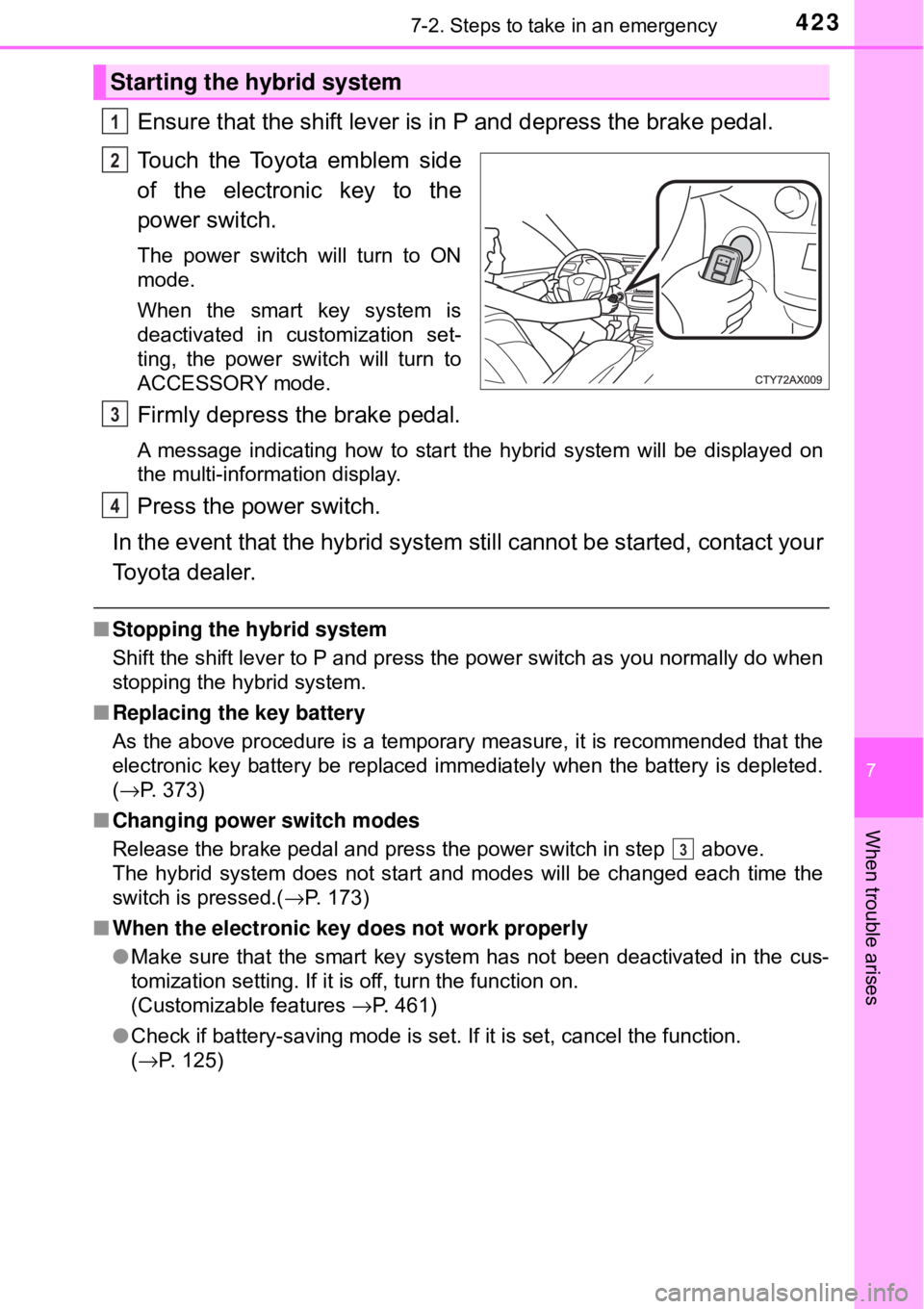
4237-2. Steps to take in an emergency
7
When trouble arises
Ensure that the shift lever is in P and depress the brake pedal.
Touch the Toyota emblem side
of the electronic key to the
power switch.
The power switch will turn to ON
mode.
When the smart key system is
deactivated in customization set-
ting, the power switch will turn to
ACCESSORY mode.
Firmly depress the brake pedal.
A message indicating how to start the hybrid system will be displayed on
the multi-information display.
Press the power switch.
In the event that the hybrid system still cannot be started, contact your
Toyota dealer.
â– Stopping the hybrid system
Shift the shift lever to P and press the power switch as you normally do when
stopping the hybrid system.
â– Replacing the key battery
As the above procedure is a temporary measure, it is recommended that the
electronic key battery be replaced immediately when the battery is depleted.
(→P. 373)
â– Changing power switch modes
Release the brake pedal and press the power switch in step above.
The hybrid system does not start and modes will be changed each time the
switch is pressed.( →P. 173)
â– When the electronic key does not work properly
â—ŹMake sure that the smart key system has not been deactivated in the cus-
tomization setting. If it is off, turn the function on.
(Customizable features →P. 461)
â—Ź Check if battery-saving mode is set. If it is set, cancel the function.
(→P. 125)
Starting the hybrid system
1
2
3
4
3
Page 424 of 492
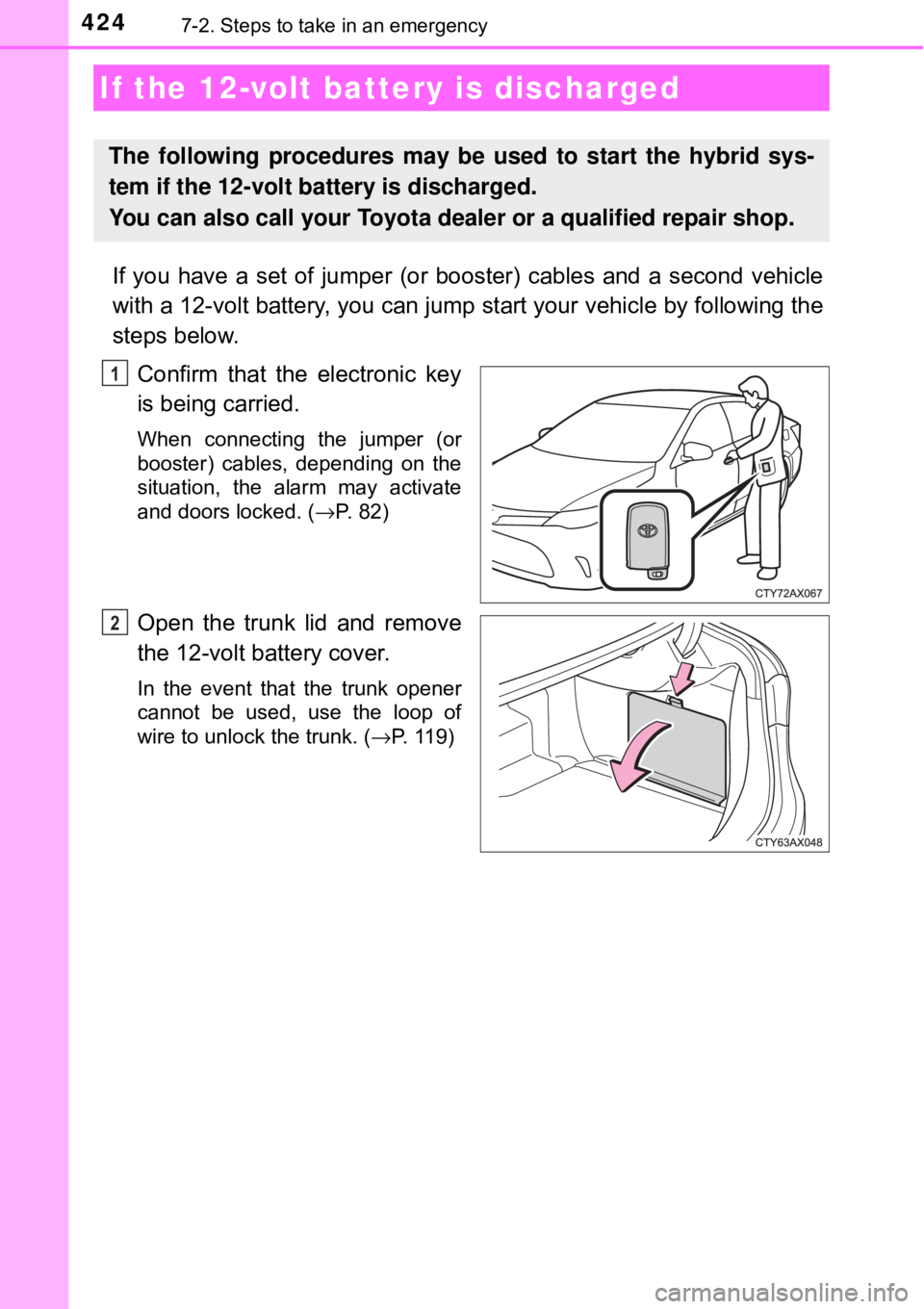
4247-2. Steps to take in an emergency
If you have a set of jumper (or booster) cables and a second vehicle
with a 12-volt battery, you can jump start your vehicle by following the
steps below.
Confirm that the electronic key
is being carried.
When connecting the jumper (or
booster) cables, depending on the
situation, the alarm may activate
and doors locked. ( →P. 82)
Open the trunk lid and remove
the 12-volt battery cover.
In the event that the trunk opener
cannot be used, use the loop of
wire to unlock the trunk. ( →P. 119)
If the 12-volt battery is discharged
The following procedures may be used to start the hybrid sys-
tem if the 12-volt battery is discharged.
You can also call your Toyota de aler or a qualified repair shop.
1
2
Page 425 of 492
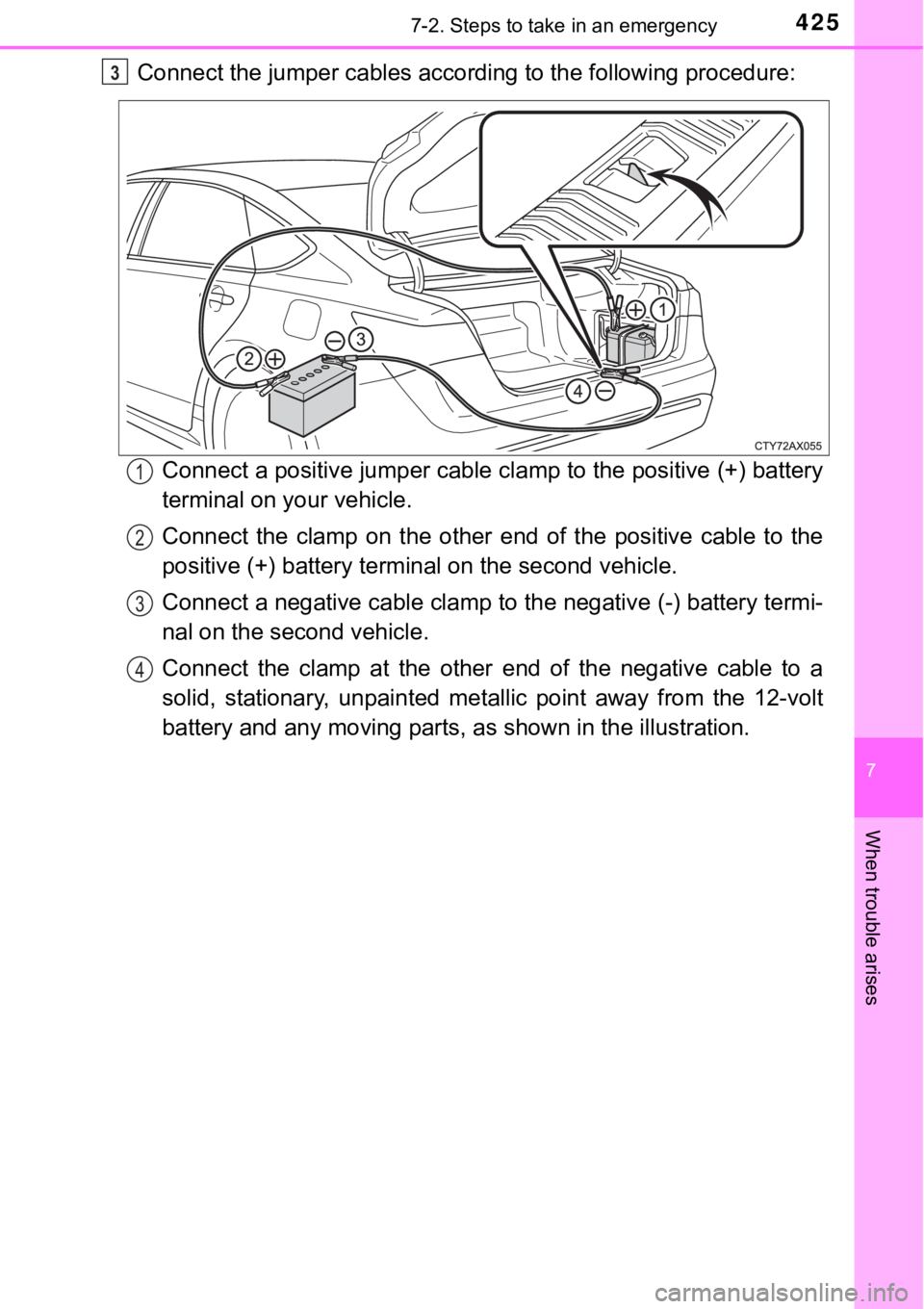
4257-2. Steps to take in an emergency
7
When trouble arises
Connect the jumper cables according to the following procedure:Connect a positive jumper cable clamp to the positive (+) battery
terminal on your vehicle.
Connect the clamp on the other e nd of the positive cable to the
positive (+) battery terminal on the second vehicle.
Connect a negative cable clamp to the negative (-) battery termi-
nal on the second vehicle.
Connect the clamp at the other end of the negative cable to a
solid, stationary, unpainted metallic point away from the 12-volt
battery and an y moving parts, as s hown in the illustration.3
1
2
3
4
Page 426 of 492

4267-2. Steps to take in an emergency
Start the engine of the second vehicle. Increase the engine speed
slightly and maintain at that level for approximately 5 minutes to
recharge the 12-volt battery of your vehicle.
Open and close any of the doors of your vehicle with the power
switch off.
Maintain the engine speed of t he second vehicle and start the
hybrid system of your vehicle by turning the power switch to ON
mode.
Make sure the “READY” indicato r comes on. If the indicator does
not come on, contact your Toyota dealer.
Once the hybrid system has start ed, remove the jumper cables in
the exact reverse order from which they were connected.
Once the hybrid system starts, ha ve the vehicle inspected at your
Toyota dealer as soon as possible.
â– Starting the hybrid system when the 12-volt battery is discharged
The hybrid system cannot be started by push-starting.
â– To prevent 12-volt battery discharge
â—ŹTurn off the headlights and the audio system while the hybrid system is off.
â—Ź Turn off any unnecessary electrical components when the vehicle is running
at a low speed for an extended period, such as in heavy traffic.
â– Charging the 12-volt battery
The electricity stored in the 12-volt battery will discharge gradually even when
the vehicle is not in use, due to natural discharge and the draining effects of
certain electrical appliances. If the vehicle is left for a long time, the 12-volt
battery may discharge, and the hybrid system may be unable to start. (The
12-volt battery recharges automatically while the hybrid system is operating.)
4
5
6
7
8
Page 427 of 492
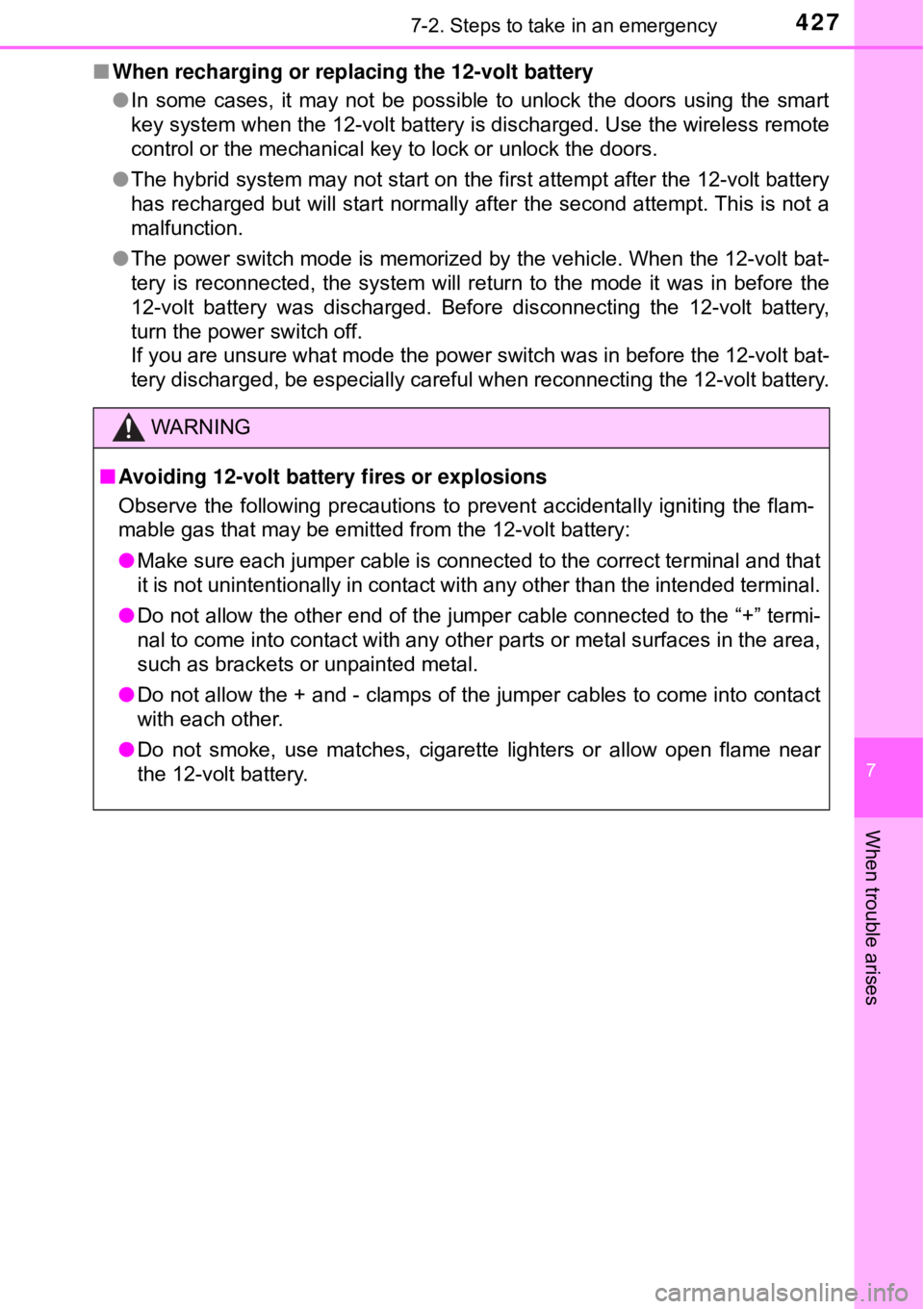
4277-2. Steps to take in an emergency
7
When trouble arises
â– When recharging or repl acing the 12-volt battery
â—Ź In some cases, it may not be possible to unlock the doors using the smart
key system when the 12-volt battery is discharged. Use the wireless remote
control or the mechanical key to lock or unlock the doors.
â—Ź The hybrid system may not start on the first attempt after the 12-volt battery
has recharged but will start normally after the second attempt. This is not a
malfunction.
â—Ź The power switch mode is memorized by the vehicle. When the 12-volt bat-
tery is reconnected, the system will return to the mode it was in before the
12-volt battery was discharged. Before disconnecting the 12-volt battery,
turn the power switch off.
If you are unsure what mode the power switch was in before the 12-volt bat-
tery discharged, be especially careful when reconnecting the 12-volt battery.
WARNING
â– Avoiding 12-volt battery fires or explosions
Observe the following precautions to prevent accidentally igniting the flam-
mable gas that may be emitted from the 12-volt battery:
â—Ź Make sure each jumper cable is connected to the correct terminal and that
it is not unintentionally in contact with any other than the intended terminal.
● Do not allow the other end of the jumper cable connected to the “+” termi-
nal to come into contact with any other parts or metal surfaces in the area,
such as brackets or unpainted metal.
â—Ź Do not allow the + and - clamps of the jumper cables to come into contact
with each other.
â—Ź Do not smoke, use matches, cigarette lighters or allow open flame near
the 12-volt battery.
Page 428 of 492

4287-2. Steps to take in an emergency
WARNING
â– 12-volt battery precautions
The 12-volt battery contains poisonous and corrosive acidic electrolyte,
while related parts contain lead and lead compounds. Observe the following
precautions when handling the 12-volt battery:
â—Ź When working with the 12-volt battery, always wear safety glasses and
take care not to allow any 12-volt battery fluids (acid) to come into contact
with skin, clothing or the vehicle body.
â—Ź Do not lean over the 12-volt battery.
â—Ź In the event that 12-volt battery fluid comes into contact with the skin or
eyes, immediately wash the affected area with water and seek medical
attention.
Place a wet sponge or cloth over the affected area until medical attention
can be received.
â—Ź Always wash your hands after handling the 12-volt battery support, termi-
nals, and other battery-related parts.
â—Ź Do not allow children near the 12-volt battery.
â– After recharging the 12-volt battery
Have the 12-volt battery inspected at your Toyota dealer as soon as possi-
ble.
If the 12-volt battery is deteriorating, continued use may cause the 12-volt
battery to emit a malodorous gas, which may be detrimental to the health of
passengers.
â– When replacing the 12-volt battery
→ P. 355
Page 429 of 492
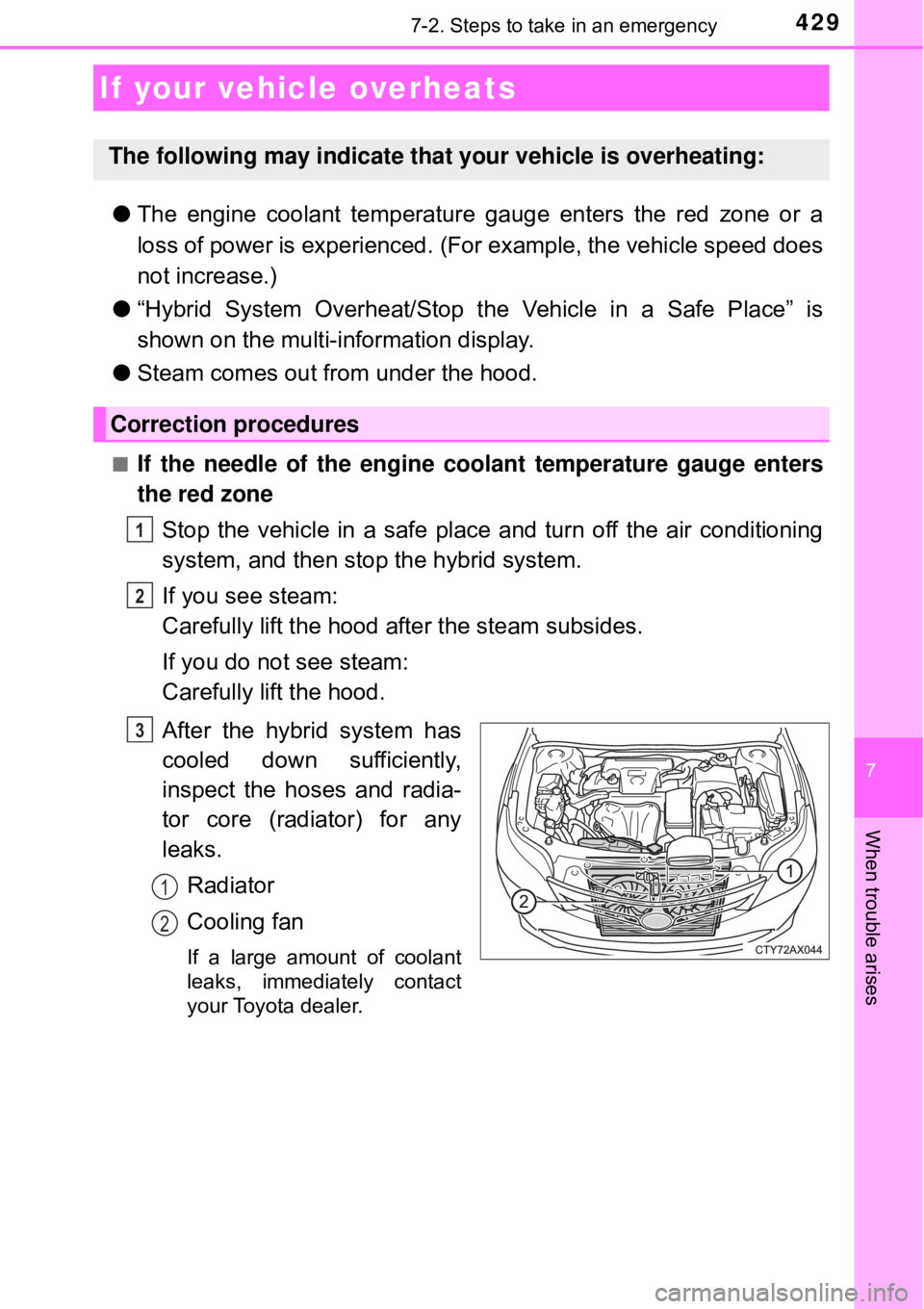
4297-2. Steps to take in an emergency
7
When trouble arises
â—ŹThe engine coolant temperature gauge enters the red zone or a
loss of power is experienced. (For example, the vehicle speed does
not increase.)
● “Hybrid System Overhe at/Stop the Vehicle in a Safe Place” is
shown on the multi-information display.
â—Ź Steam comes out from under the hood.
â– If the needle of the engine coolant temperature gauge enters
the red zone
Stop the vehicle in a safe place and turn off the air conditioning
system, and then stop the hybrid system.
If you see steam:
Carefully lift the hood after the steam subsides.
If you do not see steam:
Carefully lift the hood.
After the hybrid system has
cooled down sufficiently,
inspect the hoses and radia-
tor core (radiator) for any
leaks.Radiator
Cooling fan
If a large amount of coolant
leaks, immediately contact
your Toyota dealer.
If your vehicle overheats
The following may indicate that your vehicle is overheating:
Correction procedures
1
2
3
1
2
Page 430 of 492
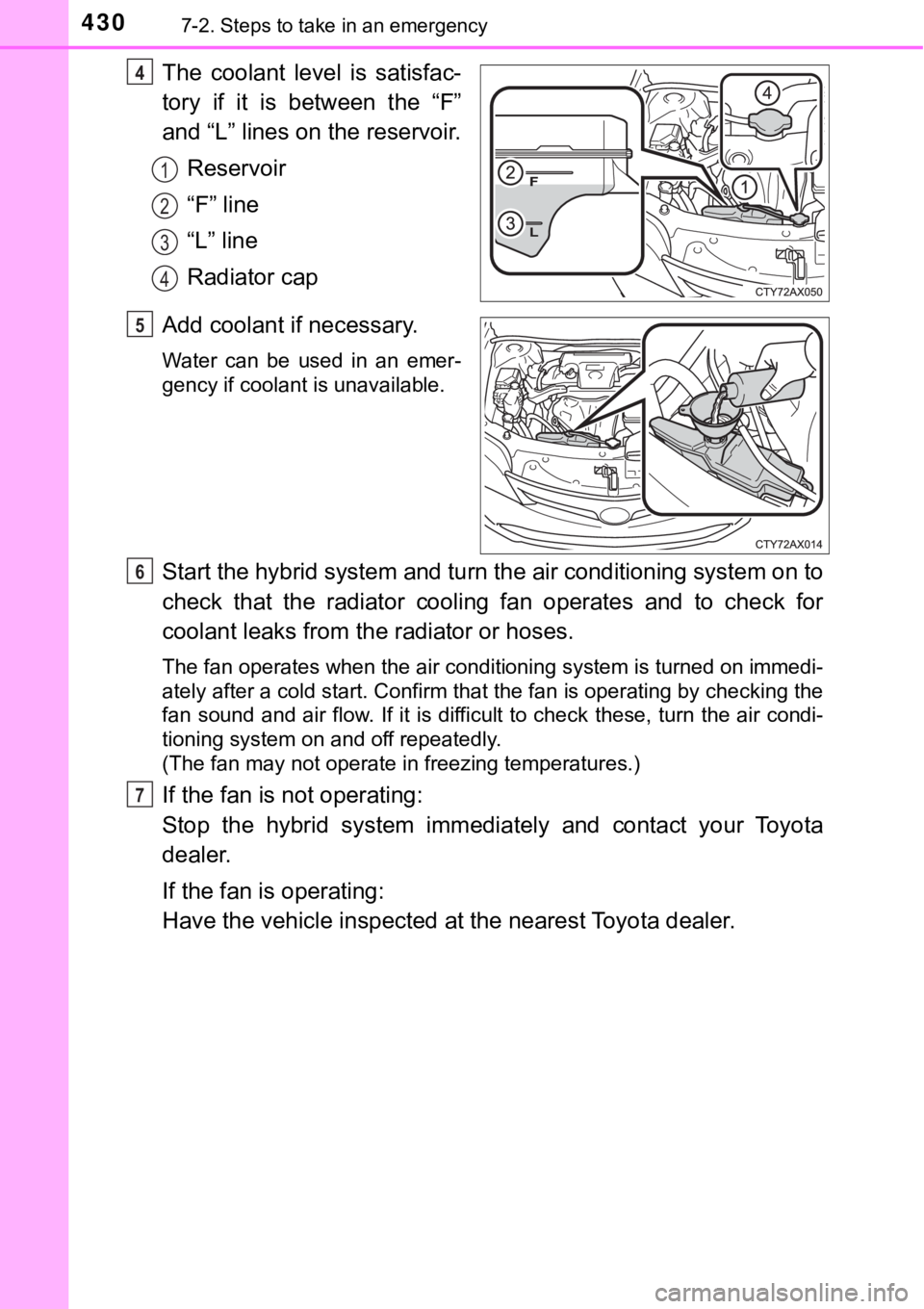
4307-2. Steps to take in an emergency
The coolant level is satisfac-
tory if it is between the “F”
and “L” lines on the reservoir.Reservoir
“F” line
“L” line
Radiator cap
Add coolant if necessary.
Water can be used in an emer-
gency if coolant is unavailable.
Start the hybrid system and turn the air conditioning system on to
check that the radiator cooling fan operates and to check for
coolant leaks from th e radiator or hoses.
The fan operates when the air conditioning system is turned on immedi-
ately after a cold start. Confirm that the fan is operating by checking \
the
fan sound and air flow. If it is difficult to check these, turn the air condi-
tioning system on and off repeatedly.
(The fan may not operate in freezing temperatures.)
If the fan is not operating:
Stop the hybrid system immediately and contact your Toyota
dealer.
If the fan is operating:
Have the vehicle inspected at the nearest Toyota dealer.
4
1
2
3
4
5
6
7